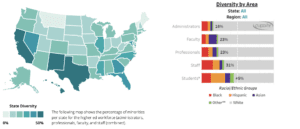Adapting DEI Hiring Practices to a Pandemic
Diversity, equity, and inclusion (DEI) in hiring is an important aspect of creating a more equitable and inclusive academic environment. The COVID-19 pandemic has highlighted and exacerbated existing disparities and inequalities in academia, making it even more crucial for institutions of higher education to prioritize DEI in hiring now.
One of the most significant challenges that the pandemic has brought to light is the lack of representation of marginalized communities in academia. Many institutions continue to struggle with diversifying their faculty and staff, with underrepresentation of people of color, women, and members of the LGBTQ+ community. The pandemic has also highlighted the ways in which the academic job market has been affected, leading to a decrease in hiring opportunities and an increase in competition for available positions.

DEI in Hiring
To address these issues, institutions must take a proactive and intentional approach to DEI in hiring. This includes actively recruiting and seeking out candidates from marginalized communities, as well as creating a more inclusive and welcoming environment during the hiring process. For example, institutions can use targeted recruitment strategies to reach out to underrepresented groups, such as advertising job openings in publications and online platforms, like ADS, that reach these communities, and partnering with organizations that support diversity in the academy. Additionally, institutions can also ensure that their hiring committees are diverse, and that bias is minimized during the hiring process, such as by blind reviewing of applications.
Ongoing Support After Hiring
Another important aspect of DEI in hiring is providing support for underrepresented groups once they are hired. This includes offering mentoring and professional development opportunities, as well as providing resources and support to help them navigate the academic environment. For example, institutions can provide opportunities for networking and connecting with other faculty and staff members from similar backgrounds and offer resources such as counseling and mental health services.
Diversify the Career Path
The pandemic has also highlighted the ways in which the academic job market has been affected, leading to a decrease in hiring opportunities and an increase in competition for available positions. Institution should be mindful of this and consider providing an alternative career path such as visiting or adjunct positions or providing support for postdocs to develop their skills and publications to increase their chances of being hired in the future.
Holistic DEI Approach
In addition to addressing these specific challenges, institutions must also take a holistic approach to DEI in hiring, ensuring that it is integrated into all aspects of the institution. This includes recruitment and hiring, curriculum development, and campus culture. For example, institutions must actively recruit and hire a diverse faculty and staff and ensure that the curriculum is inclusive and reflective of the diverse experiences and perspectives of all students. Additionally, institutions must work to create a campus culture that is inclusive and welcoming for all students, faculty, and staff.
In conclusion, the COVID-19 pandemic has highlighted and exacerbated existing disparities and inequalities in academia, particularly in terms of representation of marginalized communities in faculty and staff positions. Institutions of higher education must take a proactive and intentional approach to DEI in hiring, including active recruitment of candidates from underrepresented groups, creating a more inclusive hiring process, and providing support for underrepresented groups once they are hired. This is crucial for creating a more equitable and inclusive academic environment and will benefit the entire academic community.



